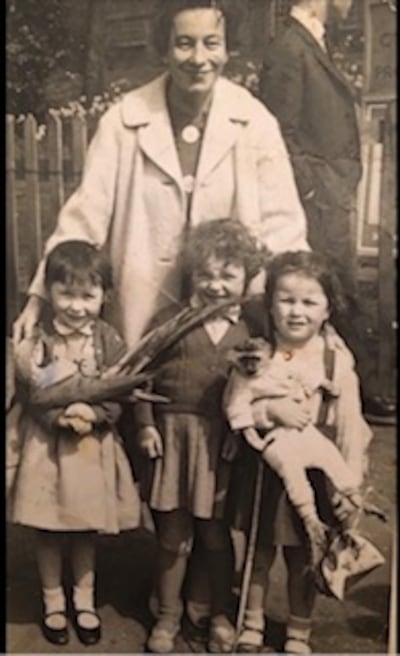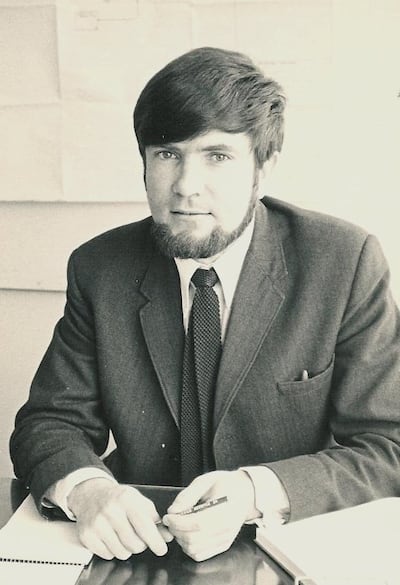Signs reading “No Irish, No Blacks, No Dogs” were “commonplace in London in the 1950s”, according to Patrick W Hurley, who arrived in the English capital from Waterford in 1955. “The common form of advertising was a plain postcard held in place by a drawing pin in a glass-fronted box on the wall or stuck with Sellotape on the inside of the window. The signs were all handwritten,” he says, recalling his search for accommodation on arrival.
Hurley is one of numerous Irish Times readers who wrote to the newspaper to recount their experiences of anti-Irish discrimination following an article last week examining the prevalence of “No Irish, No Blacks, No Dogs” signs in Britain.
The only known photograph of such a sign is from an unknown source – a picture donated in the 1980s to the archive of the Irish in Britain support group. For Frances Kelly, however, reading one such sign is an “ingrained childhood memory”.
She recalls walking around London with her mother between 1963 and 1965 and passing a specific house on Castle Road in northwest London. “In the curtained window ... [was] a handwritten sign which stated ‘No Blacks, No Irish, No Dogs.’ The cardboard was brown, the lettering was black, and each statement was in descending order from the top.”
READ MORE

[ ‘No Irish, No Blacks, No Dogs’: How common were such notices in Britain?Opens in new window ]
Recalling wider examples of anti-Irish discrimination, Hurley described how Irish people were targeted by the British police and unfairly prosecuted for minor offences. Hurley had this knowledge as he was on a Home Office team that investigated police behaviour in the Paddington and Brixton areas of London. Many of the police were “patently anti-Irish” and would plant “jemmies” in the coat pockets of the Irish, charging them with the intention of breaking and entering.
Likewise, Irish men were prosecuted for indecent exposure if they were caught urinating outdoors on their way home from the pub on a Saturday night. The police chose to charge the men under the criminal code which came with a mandatory prison sentence. Hurley described the Irish as an “easy target”.
Gerry McQuillan, who studied electrical engineering at Queen’s University Belfast in the early 1960s, worked at a pea canning factory in Norwich as a summer job alongside other Irish students. “After our shift we walked into town to the pubs for a beer and on the first occasion I was shocked to see notices outside the pubs reading ‘No Irish, No Blacks, and No Van Dwellers’. My friends and I obviously ignored the signs and didn’t experience any problems being served in the pubs,” he said.

Some years later, he worked in an engineering company in London where he received the odd comment about being “a Paddy” but didn’t see any anti-Irish signs outside pubs. He described his time in “swinging London” as a “great time with great music, great memories, and great football”.
As a 16-year-old student in Birmingham, Enda Cullen had no direct encounter of “No Irish” signs but he said he was addressed as “Paddy” by his colleagues. He recalled a time when he was playing golf when a print worker from Fleet Street refused to accept that he worked as a teacher as he “had never met an Irish teacher”.
Cullen said: “Like many other Irish, I do not need physical evidence to prove racial prejudice.” He said when he arrived back to London in 1982 after spending seven years in America, “I was very conscious of my accent and my wife, then girlfriend, was forced to do a lot of the talking”. At the time there was an increase in anti-Irish sentiment linked to the IRA’s bombing campaign in England. “I used to say that in the US, as Irish, you started 10 points up and in England 10 points down,” he said. Although, in general, “London was good to me and I prospered and developed teaching there”.
Terence Clark, a second-generation Irishman born in the Cable Street area of east London, said signs reading “No Blacks, No Irish, No Dogs” were common and in most lodging houses. He said Irish men were generally known as “navvies” back then and “could be seen after their shifts on building sites and underground tunnels wearing the de facto uniform of donkey jacket and wellingtons”.
A hard-drinking culture within this workforce has been cited by some historians as a factor behind “No Irish” sentiment at boarding houses. “Most of the men who stayed in these lodgings were single, paid weekly in cash and shared their rooms – often they hot-bedded with their shift partners,” Clark recalled.
Another Irish emigrant, who preferred to remain anonymous, said in the 1960s “No Irish” notices were “all over London, in fancy typed cards in shop windows advertising bedsits, jobs or whatever”. She remembered going for an employment agency and being told “we don’t do Irish here” when they heard her accent, although she said the Irish were not alone in being discriminated against and “we were definitely classed as one better than ‘coloureds’”.
A number of readers gave reasons for the lack of photographic or written records of such signs in Britain. Freda McKittrick said she saw a handwritten sign reading “No Blacks, No Irish” taped to the door of a pub. “In those days nobody had a mobile phone or carried a little camera around with them. I have no record of it. But I would have no difficulty in swearing an affidavit as to its existence.”
Hurley added “we didn’t walk around with cameras in those days. Photocopiers hadn’t been invented, so how would anyone be able to copy a postcard in a window other than by asking for it and why would anyone do that?”
- Sign up for push alerts and have the best news, analysis and comment delivered directly to your phone
- Find The Irish Times on WhatsApp and stay up to date
- Listen to our Inside Politics podcast for the best political chat and analysis
















